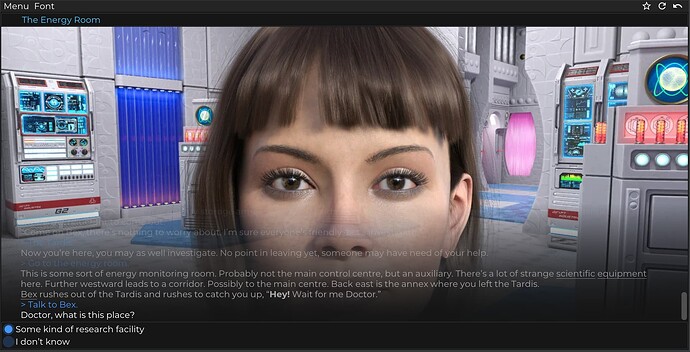You Can’t Save Her by Sarah Mak
The blurb for You Can’t Save Her describes it as “a 12-minute interactive story”. The title screens offers the chance to start or go through individual chapters. There are five of them.
“Five chapters?! In a 12 minute game?!” I would have exclaimed this loudly, but I had just put the kids to sleep.
Nevertheless I plowed on. The game begins with “It will always end the same way.” As I took a breath and prepared to dive into the narrative… It gave me an interactive content warning. A content warning that is both neat in that it lets you click on a term and let it expand, but also clumsy in that the first click doesn’t tell you anything except “clicking this will tell you more”. This awkward stumble of IF literacy felt like the first jolt of a roller coaster leaving the station.
Next, it said, “Headphones recommended.” I was torn. The kids remained asleep and no author will get on my good side if they recommend sound and I come to regret it. Final Call had a decent audioscape, but the random casino sounds almost had me undone. Imprimatura had some beautiful music floating under the game. I had to give You Can’t Save Her a chance as well. I took another deep breath and turned the volume up a little.
And look, I’m not going to walk you through my every moment with You Can’t Save Her, but my growing sense of wariness ended up being unwarranted. This is a narrative game of two friends who find themselves either side of a religious divide, how they got there and their attempts to resolve it. It was reminiscent of an anime or manga, with quiet, emotionally-laden moments that explode into superheroic clashes of swords.
Once the story gets going, the chapters makes sense. The two characters are pink and blue, as seen in the cover art, and cleverly laced into the hyperlinks for each section. From the perspective of blue, all links are blue, and pink for pink. The narrative bounces between the two characters, as well as two times, before and after. Without the visual cues, this could be extremely confusing, especially with the sparse text. But it works well here. As chapters ticked by, I had a sense of a mutual gravity between the two characters, spinning around each other like two lost moons, each one threatening to spin off into oblivion at any moment.
You Can’t Save Her employs a number of hyperlink tricks. Despite timed text and overloading what it means to click a link - sometimes it cycles through choices, other times it cycles through a few before resolving into plain text, and others it advances the scene - these all work reasonably well without too much confusion or clunkiness with how Twine works. The transitions between scenes effectively use colour to convey information.
The times they don’t work well is when they take an effective use, and repeat it too soon after and too similarly (the “I’m sorry” section). Sometimes the timing is a little off and you wonder if the game is broken and forgot to advance. Another has a scene where the antagonist dodges out of the way of a bullet and disappears into the darkness. You are asked to chase her:
She could be to the north, north by east, north-northeast, northeast by north, northeast, northeast by east, east-northeast, east by north, east, east by south, east-southeast, southeast by east, southeast, southeast by south, south-southeast, south by east, south, south by west, south-southwest, southwest by south, southwest, southwest by west, west-southwest, west by south, west, west by north, west-northwest, northwest by west, northwest, northwest by north, north-northwest, or north by west.
Each of these directions is an option. To which I thought, “FORGET THIS”. But it’s a false choice and one that risks overloading the player and jolting them out of the story.
The music is by Falling Islands and works effectively. Occasionally the timing of scene changes or when the song loops was accidentally awkward but these are hard problems to deal with, especially in Twine.
Although the story didn’t quite deliver the emotional or philosophical punch I was hoping for, it was nevertheless a deftly crafted piece with considerable care and polish.
